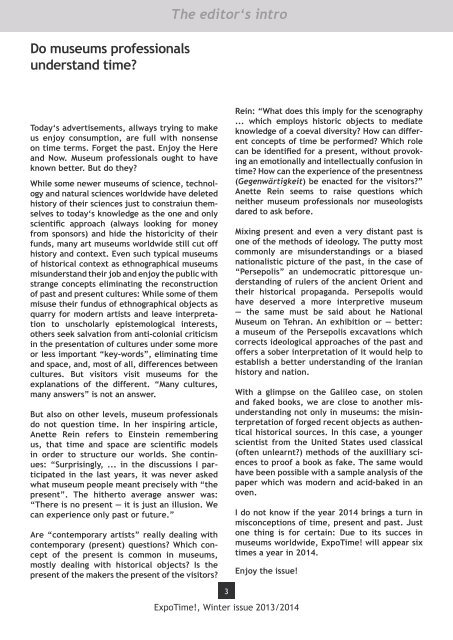Rein-2013-Contemporary-issues-in-museums
Rein-2013-Contemporary-issues-in-museums
Rein-2013-Contemporary-issues-in-museums
You also want an ePaper? Increase the reach of your titles
YUMPU automatically turns print PDFs into web optimized ePapers that Google loves.
Do <strong>museums</strong> professionals<br />
understand time?<br />
The editor‘s <strong>in</strong>tro<br />
Today‘s advertisements, allways try<strong>in</strong>g to make<br />
us enjoy consumption, are full with nonsense<br />
on time terms. Forget the past. Enjoy the Here<br />
and Now. Museum professionals ought to have<br />
known better. But do they?<br />
While some newer <strong>museums</strong> of science, technology<br />
and natural sciences worldwide have deleted<br />
history of their sciences just to constraiun themselves<br />
to today‘s knowledge as the one and only<br />
scientific approach (always look<strong>in</strong>g for money<br />
from sponsors) and hide the historicity of their<br />
funds, many art <strong>museums</strong> worldwide still cut off<br />
history and context. Even such typical <strong>museums</strong><br />
of historical context as ethnographical <strong>museums</strong><br />
misunderstand their job and enjoy the public with<br />
strange concepts elim<strong>in</strong>at<strong>in</strong>g the reconstruction<br />
of past and present cultures: While some of them<br />
misuse their fundus of ethnographical objects as<br />
quarry for modern artists and leave <strong>in</strong>terpretation<br />
to unscholarly epistemological <strong>in</strong>terests,<br />
others seek salvation from anti-colonial criticism<br />
<strong>in</strong> the presentation of cultures under some more<br />
or less important “key-words”, elim<strong>in</strong>at<strong>in</strong>g time<br />
and space, and, most of all, differences between<br />
cultures. But visitors visit <strong>museums</strong> for the<br />
explanations of the different. “Many cultures,<br />
many answers” is not an answer.<br />
But also on other levels, museum professionals<br />
do not question time. In her <strong>in</strong>spir<strong>in</strong>g article,<br />
Anette <strong>Re<strong>in</strong></strong> refers to E<strong>in</strong>ste<strong>in</strong> remember<strong>in</strong>g<br />
us, that time and space are scientific models<br />
<strong>in</strong> order to structure our worlds. She cont<strong>in</strong>ues:<br />
“Surpris<strong>in</strong>gly, ... <strong>in</strong> the discussions I participated<br />
<strong>in</strong> the last years, it was never asked<br />
what museum people meant precisely with “the<br />
present”. The hitherto average answer was:<br />
“There is no present ― it is just an illusion. We<br />
can experience only past or future.”<br />
Are “contemporary artists” really deal<strong>in</strong>g with<br />
contemporary (present) questions? Which concept<br />
of the present is common <strong>in</strong> <strong>museums</strong>,<br />
mostly deal<strong>in</strong>g with historical objects? Is the<br />
present of the makers the present of the visitors?<br />
<strong>Re<strong>in</strong></strong>: “What does this imply for the scenography<br />
... which employs historic objects to mediate<br />
knowledge of a coeval diversity? How can different<br />
concepts of time be performed? Which role<br />
can be identified for a present, without provok<strong>in</strong>g<br />
an emotionally and <strong>in</strong>tellectually confusion <strong>in</strong><br />
time? How can the experience of the presentness<br />
(Gegenwärtigkeit) be enacted for the visitors?”<br />
Anette <strong>Re<strong>in</strong></strong> seems to raise questions which<br />
neither museum professionals nor museologists<br />
dared to ask before.<br />
Mix<strong>in</strong>g present and even a very distant past is<br />
one of the methods of ideology. The putty most<br />
commonly are misunderstand<strong>in</strong>gs or a biased<br />
nationalistic picture of the past, <strong>in</strong> the case of<br />
“Persepolis” an undemocratic pittoresque understand<strong>in</strong>g<br />
of rulers of the ancient Orient and<br />
their historical propaganda. Persepolis would<br />
have deserved a more <strong>in</strong>terpretive museum<br />
— the same must be said about he National<br />
Museum on Tehran. An exhibition or — better:<br />
a museum of the Persepolis excavations which<br />
corrects ideological approaches of the past and<br />
offers a sober <strong>in</strong>terpretation of it would help to<br />
establish a better understand<strong>in</strong>g of the Iranian<br />
history and nation.<br />
With a glimpse on the Galileo case, on stolen<br />
and faked books, we are close to another misunderstand<strong>in</strong>g<br />
not only <strong>in</strong> <strong>museums</strong>: the mis<strong>in</strong>terpretation<br />
of forged recent objects as authentical<br />
historical sources. In this case, a younger<br />
scientist from the United States used classical<br />
(often unlearnt?) methods of the auxilliary sciences<br />
to proof a book as fake. The same would<br />
have been possible with a sample analysis of the<br />
paper which was modern and acid-baked <strong>in</strong> an<br />
oven.<br />
I do not know if the year 2014 br<strong>in</strong>gs a turn <strong>in</strong><br />
misconceptions of time, present and past. Just<br />
one th<strong>in</strong>g is for certa<strong>in</strong>: Due to its succes <strong>in</strong><br />
<strong>museums</strong> worldwide, ExpoTime! will appear six<br />
times a year <strong>in</strong> 2014.<br />
Enjoy the issue!<br />
3<br />
ExpoTime!, W<strong>in</strong>ter issue <strong>2013</strong>/2014


